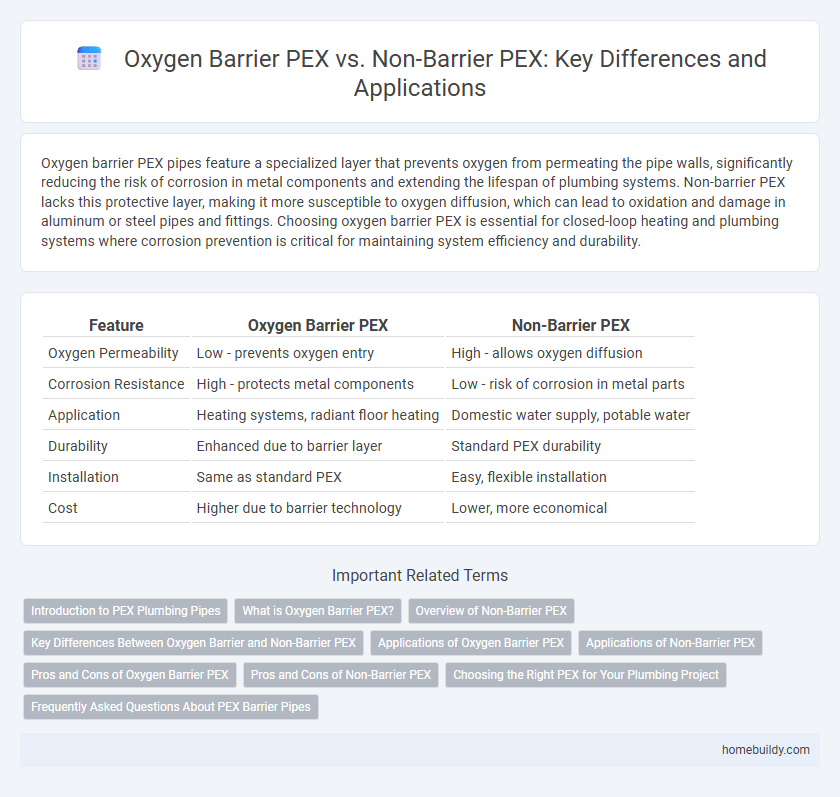Oxygen barrier PEX pipes feature a specialized layer that prevents oxygen from permeating the pipe walls, significantly reducing the risk of corrosion in metal components and extending the lifespan of plumbing systems. Non-barrier PEX lacks this protective layer, making it more susceptible to oxygen diffusion, which can lead to oxidation and damage in aluminum or steel pipes and fittings. Choosing oxygen barrier PEX is essential for closed-loop heating and plumbing systems where corrosion prevention is critical for maintaining system efficiency and durability.
Table of Comparison
| Feature | Oxygen Barrier PEX | Non-Barrier PEX |
|---|---|---|
| Oxygen Permeability | Low - prevents oxygen entry | High - allows oxygen diffusion |
| Corrosion Resistance | High - protects metal components | Low - risk of corrosion in metal parts |
| Application | Heating systems, radiant floor heating | Domestic water supply, potable water |
| Durability | Enhanced due to barrier layer | Standard PEX durability |
| Installation | Same as standard PEX | Easy, flexible installation |
| Cost | Higher due to barrier technology | Lower, more economical |
Introduction to PEX Plumbing Pipes
PEX plumbing pipes come in two main types: Oxygen Barrier PEX and Non-Barrier PEX, each designed for specific applications. Oxygen Barrier PEX features a special layer to prevent oxygen infiltration, protecting metal components in closed-loop heating systems from corrosion. Non-Barrier PEX is ideal for potable water supply, offering flexibility, durability, and resistance to chemical damage without the need for an oxygen barrier.
What is Oxygen Barrier PEX?
Oxygen Barrier PEX is a type of cross-linked polyethylene piping designed to prevent oxygen infiltration, which reduces corrosion in metal components of plumbing systems. This pipe features a specialized layer that blocks oxygen molecules from permeating through the pipe walls, ensuring longer-lasting system durability in radiant heating and potable water applications. Compared to Non-Barrier PEX, Oxygen Barrier PEX is preferred for closed-loop systems where oxygen exposure can lead to rust and degradation of metal parts like boilers and pumps.
Overview of Non-Barrier PEX
Non-Barrier PEX is a cross-linked polyethylene tubing commonly used in plumbing systems due to its flexibility, durability, and corrosion resistance. Unlike Oxygen Barrier PEX, Non-Barrier PEX lacks an oxygen-blocking layer, making it unsuitable for use in heating systems with metal components that are susceptible to oxidation. Its cost-effectiveness and ease of installation make Non-Barrier PEX ideal for residential potable water systems where oxygen permeability is not a concern.
Key Differences Between Oxygen Barrier and Non-Barrier PEX
Oxygen Barrier PEX contains a specialized layer that prevents oxygen from permeating the pipe walls, reducing the risk of corrosion in metal components within heating systems. Non-Barrier PEX lacks this protective layer, making it suitable primarily for potable water delivery but less ideal for closed-loop heating applications where oxygen infiltration can cause damage. The key difference lies in the barrier's ability to extend the lifespan of system components by maintaining water purity and preventing oxidation-related failures.
Applications of Oxygen Barrier PEX
Oxygen barrier PEX pipes are primarily used in heating systems, such as radiant floor heating and closed-loop hydronic heating, where preventing oxygen diffusion is crucial to avoid corrosion of metal components. These pipes are ideal for applications requiring enhanced longevity and system reliability by maintaining water purity and minimizing oxidation. Non-barrier PEX is more suited for potable water supply lines where oxygen infiltration poses less risk.
Applications of Non-Barrier PEX
Non-barrier PEX is primarily used in radiant heating systems and domestic water supply where oxygen diffusion is not a concern. It is preferred in applications involving potable water plumbing and hydronic heating due to its flexibility and resistance to corrosion. Non-barrier PEX tubing is ideal for interior use where oxygen permeability does not affect system performance or longevity.
Pros and Cons of Oxygen Barrier PEX
Oxygen Barrier PEX tubing effectively prevents oxygen from permeating the pipe walls, reducing corrosion risk in metal components of hydronic heating systems and extending system lifespan. It offers superior durability and resistance to oxygen-induced degradation compared to Non-Barrier PEX but typically comes at a higher cost and limited flexibility for certain plumbing installations. Its use is ideal in closed-loop heating systems where oxygen diffusion control is critical, though it may be unnecessary for simple potable water applications where corrosion is less of a concern.
Pros and Cons of Non-Barrier PEX
Non-barrier PEX pipes offer cost-effectiveness and excellent flexibility, making them suitable for potable water and radiant heating systems that do not require protection from oxygen infiltration. However, the absence of an oxygen barrier allows oxygen diffusion, which can lead to corrosion of metal components in hydronic heating systems and reduce system longevity. These pipes are ideal where oxygen exposure is minimal, but less appropriate for applications requiring enhanced resistance to oxygen permeation.
Choosing the Right PEX for Your Plumbing Project
Oxygen Barrier PEX pipes prevent oxygen infiltration, reducing the risk of corrosion in metal components and extending the lifespan of your plumbing system, making them ideal for hydronic heating and closed-loop systems. Non-Barrier PEX, while more cost-effective and flexible, is suitable for potable water applications and open-loop systems where oxygen exposure is minimal. Selecting the right PEX depends on the specific requirements of your project, including system type, budget, and long-term durability needs.
Frequently Asked Questions About PEX Barrier Pipes
Oxygen Barrier PEX pipes feature a protective layer that prevents oxygen from permeating the pipe walls, reducing the risk of corrosion in metal components and extending the lifespan of plumbing systems. Non-Barrier PEX pipes lack this layer, making them suitable for residential water supply but less ideal for hydronic heating systems where oxygen infiltration can cause damage. Frequently asked questions about PEX barrier pipes often address compatibility with various heating systems, installation methods, and long-term durability compared to non-barrier alternatives.
Oxygen Barrier PEX vs Non-Barrier PEX Infographic

 homebuildy.com
homebuildy.com